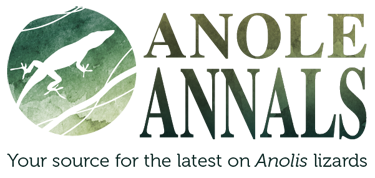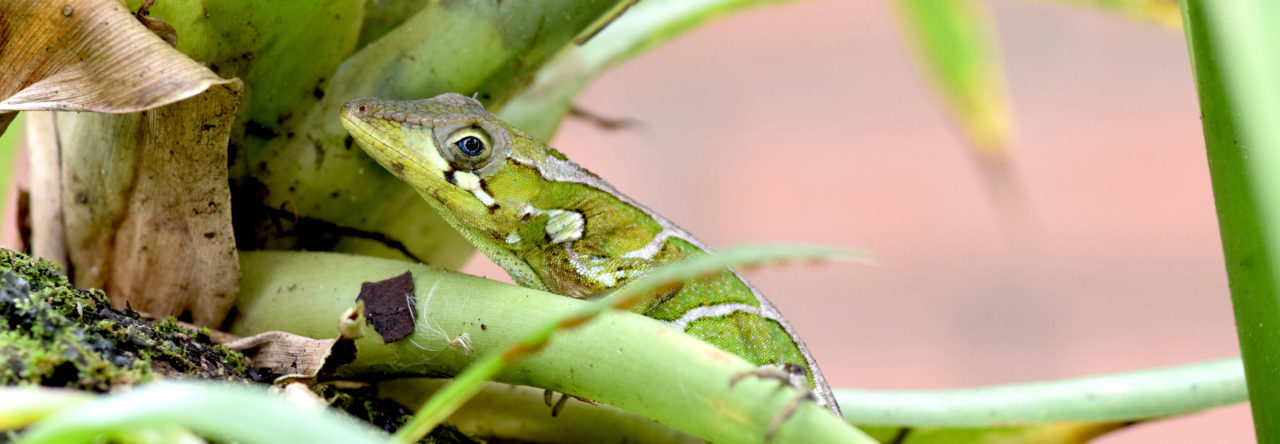from the front page of the South Florida Sun Sentinel, above the fold!
The lizard wars of South Florida help reveal how evolution works

Evolutionary biologist James Stroud holds a crested anole caught by his mini lasso on an island at Fairchild Tropical Botanic Gardens in Coral Gables. Scientists are studying how the brown anole from Cuba and the crested anole from Puerto Rico compete with one another and drive each species to adapt and find slightly different niches in the ecosystem. (Joe Cavaretta/South Florida Sun Sentinel)
CORAL GABLES — Fairchild Tropical Botanic Garden may look serene at first glance, but beneath the resplendent orchids and majestic banyans, two invasive lizards are waging a turf war.
The war started a few years ago when Cuban brown anoles, who have called South Florida home for about 100 years, came face to face for the first time with a new rival: crested anoles from Puerto Rico.
As the two species, which look almost identical and occupy the same ecological niche, faced off, biologists were able to document who was winning, and more importantly, how quickly the losers were adapting to survive on new turf.
A new study reveals that the losing species is adapting at a rapid pace, changing their behavior, but also their bodies. This fast adaptation is altering what we know about how evolution works.
Nearly identical invaders
Brown and crested anoles are almost identical — lanky, 4 to 8 inches long, splotchy brown and skittish (lots of animals eat them). But the cresteds are slightly bigger, and the males grow a crest on their tails.
Both lizards evolved on separate Caribbean islands to perch on tree trunks where they can scan the forest floor dart into leaf little to snag meals such as spiders and roaches.
But they’ve never had to compete against each other. “They’re convergently evolved,” said Georgia Tech evolutionary biologist James Stroud, who led the team of researchers on the study.
“They evolved completely independently. … Their last common ancestor is probably around 60 million years ago. To put that in perspective, humans and chimps, their last common ancestor was 13 to 16 million years ago. So the lizards are deeply deeply diverged.”
Stroud said that in 2018, crested anoles showed up at Fairchild Tropical Botanic Garden, where he’d already been studying survival rates and evolutionary adaptation of the brown anoles.

The arrival provided Stroud and his team the opportunity to study, in real time, how quickly species can adapt under pressure.
They used a fishing pole with a tiny lasso on the end to catch every lizard on an island at Fairchild the size of a football field. They then measured their physical traits, tagged them with ID numbers, released them exactly where they caught them, and spent months observing them. They then recaptured the survivors several months later.
“What we saw was when they came into contact, the cresteds, which are a little bit bigger, can dominate behaviorally, so they pushed the browns to the ground,” said Stroud. In other words, the crested anoles won the turf war, and the browns moved to a more dangerous place with a lousy view.
The territory change showed behavioral elasticity, but Stroud was also interested in physical adaptation. His team found that over time, brown anoles with longer legs had higher survival rates after the crested anoles showed up.
Researchers also tested the finding at other lizard hot spots around South Florida. They discovered that wherever brown and crested anoles had to compete for territory, the browns became more land-based, and those with longer legs lived longer. If there were no crested anoles present, long legs did not correlate with better survival.

“Before the cresteds arrived, when the browns were not living on the ground much, leg length didn’t really matter to survival,” Stroud said. “But as soon as the crested anoles arrived, brown anoles with relatively longer legs survived better. … Now that brown anoles have shifted where they’re living — suddenly there’s an adaptive benefit to having longer legs.”
Stroud suspects that the longer legs helped the browns run faster to escape predators such as herons, egrets, mocking birds and larger invasive brown basilisk lizards from Central America.
From that survival rate, he and other evolutionary biologists can gain a clearer understanding of how natural selection, and thus evolution, is operating in the world.
“This is called microevolutionary dynamics,” Stroud said. Over the past 40 or 50 years, evolutionary biologists have begun to realize that evolution might actually happen quickly enough to record in something as short as a 10-year field study. “We never thought it was possible,” Stroud said.
This bucks against one of main tenants of Charles Darwin’s theory of evolution, that evolution happens very, very slowly over time.
Darwin’s notion of slow evolution made sense at the time, Stroud said. Some fossil records don’t change at all for 50 million years. “Slow gradual change through the fossil records was the evidence Darwin used to think that evolution moved at a really, really slow pace,” Stroud said.
But Stroud’s lizards in this study, as well as previous ones, show rapid changes almost constantly. Anoles live short, fast lives. Males rarely survive longer than a year, and females sometimes eke out two years of life. And they’re constantly laying eggs.
Their generations compile quickly compared to humans and other large mammals. “We think these sorts of evolutionary dynamics play out in all organisms, it just changes relative to the organism’s life history,” Stroud said.

If brown anoles at Fairchild evolve to have longer legs, that doesn’t mean they’ll change the species globally. These blips in traits can fade. But if the pressure is right, if natural selection is strong and widespread, “it can lead to rapid evolutionary change,” Stroud said.
The Lizard Olympics
Stroud isn’t done with South Florida’s invasive lizards. He’s currently conducting a study that he’s dubbed the “Lizard Olympics.”
This past spring, he and the team tested the hundreds of lizards they’ve caught on the island for various physical skills. They tested their speed on a race track; they tested their bite strength with a highly sensitive bite meter; and they tested their grip strength by placing them on leaves and bark surfaces and pulling them off.
They then tagged them and let them go on the island, and will later recapture them to see if those skills correlate to better survival for different species.
Stroud said they’ve already inferred longer legs mean faster speed and thus better survival for brown anoles, but now they’re testing it directly.
He anticipates that each species will have different skill-survival correlations: running speed might be irrelevant to the tree-dwelling green anoles, but grip strength might be important, while brown anoles might need more speed.

The lizards are being put to the test, but so are the researchers. “My students are hating me, because we just finished processing 2.5 thousand slo-mo videos of lizards running.”
Quick localized evolution, and what it means for the bigger picture of a species, is something Stroud and his peers are trying to understand — how these micro events fit into the macro story of a species.
“We now know that evolution can happen on really rapid evolutionary time scales, but what does that mean for the creation of new species?”
South Florida, with its menagerie of invasive species, gives them a unique opportunity to cast a bit more light on the mystery.











